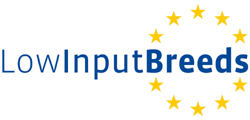LowInputBreeds Technical Notes
LowInputBreeds Technical Notes
On this page
1.1 Genomic breeding programs – a large step forward for low-input dairy cattle breeding?
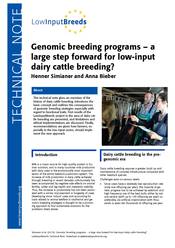
The increase of milk production in dairy cattle achieved through breeding in recent decades unfortunately has been accompanied by negative side effects on animal fertility, udder and leg health and metabolic stability. Thus, the increase in productivity has not been associated with a similar improvement in longevity of cows. Developing more ‘robust’ cows and accounting for traits related to animal welfare in traditional and genomic breeding strategies is thought to be a promising approach to find sustainable solutions for the problems listed above.
This technical note gives an overview of the history of dairy cattle breeding, introduces the basic concept and outlines the consequences of genomic breeding strategies especially with regard to functional traits. First results of the LowInputBreeds project in the area of dairy cattle breeding are presented, and limitations and ethical implementations are discussed. Finally, recommendations are given how farmers, es-pecially in the low input sector, should implement the new approach.
Citation and Download
Simianer et al. (2014): ![]() Genomic breeding programs – a large step forward for low-input dairy cattle breeding? (400 KB)LowInputBreeds technical note 1.1. Consortium of the LowInputBreeds project. Newcastle and Frick.
Genomic breeding programs – a large step forward for low-input dairy cattle breeding? (400 KB)LowInputBreeds technical note 1.1. Consortium of the LowInputBreeds project. Newcastle and Frick.
1.3 Feeding for milk fat quality
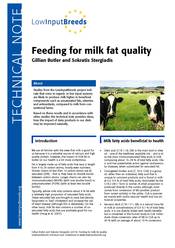
Milk is a complex matrix of many different compounds with some having negative and some beneficial impacts on human health. Studies from the LowInputBreeds project indicate that cows in organic or low input systems are likely to produce milk higher in beneficial components such as unsaturated fats, vitamins and antioxidants, compared to milk from conventional farms.
Based on these results and in accordance with other studies this technical note provides ideas, how milk fat quality may be improved naturally.
Citation and Download
Gillian Butler and Sokratis Stergiadis (2014): ![]() Feeding for milk fat quality. (135 KB) LowInputBreeds technical note 1.3. Consortium of the LowInputBreeds project. Newcastle and Frick.
Feeding for milk fat quality. (135 KB) LowInputBreeds technical note 1.3. Consortium of the LowInputBreeds project. Newcastle and Frick.
2.1 Dairy sheep breeding
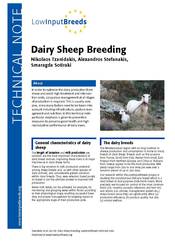
In order to optimize dairy production from sheep in the Mediterranean region and avoid high treatment and intervention costs, scrupulous management at all stages of production is required. This task is usually complex, since many factors need to be taken into account including infrastructure, pasture management and nutrition.
In this technical note particular emphasis is given to preventive measures to preserve good health and high reproductive performance of dairy ewes.
Citation and Download
Tzanidakis et al. (2014): ![]() Dairy sheep breeding. (427 KB)LowInputBreeds technical note 2.1. Consortium of the LowInputBreeds project. Newcastle and Frick.
Dairy sheep breeding. (427 KB)LowInputBreeds technical note 2.1. Consortium of the LowInputBreeds project. Newcastle and Frick.
2.2 Issues and challenges for lamb meat quality from organic and grassland based systems
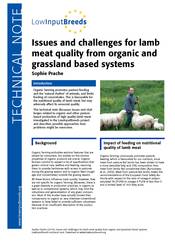
Organic farming promotes pasture-feeding and the ‘natural rhythm’ of animals, and limits feeding of concentrates. This is favourable for the nutritional quality of lamb meat, but may adversely affect its sensorial quality.
This technical note discusses issues and challenges related to organic and other pasture based production of high quality lamb meat investigated in the LowInputBreeds project and describes possible approaches how problems might be overcome.
Citation and Download
Sophie Prache (2014): ![]() Issues and challenges for lamb meat quality from organic and grassland based systems. (327 KB) LowInputBreeds technical note 2.2. Consortium of the LowInputBreeds project. Newcastle and Frick.
Issues and challenges for lamb meat quality from organic and grassland based systems. (327 KB) LowInputBreeds technical note 2.2. Consortium of the LowInputBreeds project. Newcastle and Frick.
2.3 Impact of grazing management on lamb meat quality
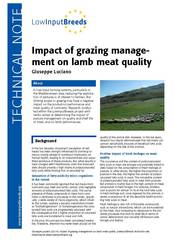
In low-input farming systems, particularly in the Mediterranean area, reducing the exploitation of pastures is of interest to farmers. But limiting access to grazing may have a negative impact on the production performance and meat quality of ruminants.
Research conducted within the LowInputBreeds project with lambs aimed at determining the impact of pasture management on quality and shelf life of meat, and on lamb performances. This technical note summarizes the findings of this research.
Citation and Download
Giuseppe Luciano (2014): ![]() Impact of grazing management on lamb meat quality. (258 KB) LowInputBreeds Technical Note 2.3. Consortium of the LowInputBreeds project. Newcastle and Frick.
Impact of grazing management on lamb meat quality. (258 KB) LowInputBreeds Technical Note 2.3. Consortium of the LowInputBreeds project. Newcastle and Frick.
2.4 Impacts of the diet on sheep milk quality under Mediterranean conditions
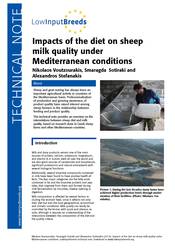
Sheep and goat rearing has always been an important agricultural activity in countries of the Mediterranean basin. Professionalization of production and growing awareness of product quality have raised interest among sheep farmers in the relationship between feeding and product quality.
This technical note provides an overview on the interrelations between sheep diet and milk quality, based on research done in Greek sheep farms and other Mediterranean countries.
Citation and Download
Nikolaos Voutzourakis, Smaragda Sotiraki and Alexandros Stefanakis (2014): ![]() Impacts of the diet on sheep milk quality under Mediterranean conditions (235 KB). LowInputBreeds technical note 2.4. Consortium of the LowInputBreeds project. Newcastle and Frick.
Impacts of the diet on sheep milk quality under Mediterranean conditions (235 KB). LowInputBreeds technical note 2.4. Consortium of the LowInputBreeds project. Newcastle and Frick.
2.5 Alternative control of gastro intestinal nematodes in low-input sheep and goat production
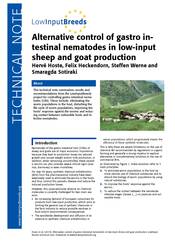
Nematodes of the gastro intestinal tract of sheep and goats are of major economic importance because they lead to production losses via reduced growth and carcass weight and/or milk production. In addition, when remaining uncontrolled, these parasitic worms can also provoke anemia or diarrhoea or even mortalities.
Extensive use of synthetic chemical anthelmintics from the pharmaceutical industry, which habe been used to eliminate the worms in the hosts, has resulted in worldwide development and diffusion of resistance to the agents in worm populations. Also, there is an increasing demand of European consumers for products from low-input production, which aims at limiting the general use of synthetic chemicals in the farm industry to reduce possible residues in food and/or environmental consequences.
This technical note summarizes results and recommendations from the LowInputBreeds project for controlling gastro intestinal nematodes. These include: eliminating the worm populations in the host, disturbing the life-cycle of worm populations, improving the hosts’ response against the worms and reducing contact between vulnerable hosts and infective nematodes.
Citation and Download
Hoste et al. (2014): ![]() Alternative control of gastro intestinal nematodes in low-input sheep and goat production (496 KB). LowInputBreeds technical note 2.5. Consortium of the LowInputBreeds project. Newcastle and Frick.
Alternative control of gastro intestinal nematodes in low-input sheep and goat production (496 KB). LowInputBreeds technical note 2.5. Consortium of the LowInputBreeds project. Newcastle and Frick.
2.6 Sainfoin, a natural anthelmintic for small ruminants?
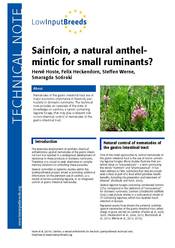
Nematodes of the gastro intestinal tract are of major economic importance in livestock, particularly in domestic ruminants.
This technical note provides an overview of the state of knowledge on sainfoin, a tannin containing legume forage, that may play a relevant role in non-chemical control of nematodes of the gastro intestinal tract.
Citation and Download
Hoste et al. (2014): ![]() Sainfoin, a natural anthelmintic for livestock. (503 KB) LowInputBreeds technical note 2.6. Consortium of the LowInputBreeds project. Newcastle and Frick.
Sainfoin, a natural anthelmintic for livestock. (503 KB) LowInputBreeds technical note 2.6. Consortium of the LowInputBreeds project. Newcastle and Frick.
3.1 Breeding for organic and low input pig production systems
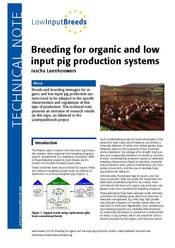
Breeds and breeding strategies for organic and low input pig production systems need to be adapted to the specific characteristics and regulations of this type of production.
This technical note presents an overview of research results on this topic, as obtained in the LowInputBreeds project.
Citation and download
Jascha Leenhouwers (2014): ![]() Breeding for organic and low input pig production systems. (336 KB) LowInputBreeds technical note 3.1. Consortium of the LowInputBreeds project. Newcastle and Frick.
Breeding for organic and low input pig production systems. (336 KB) LowInputBreeds technical note 3.1. Consortium of the LowInputBreeds project. Newcastle and Frick.
3.2 Challenges and solutions to problems in pork quality
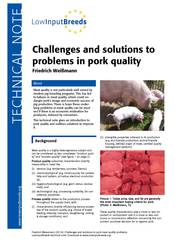
Meat quality is not particularly well served by modern pig breeding programs. This has led to failures in meat quality, which could endanger pork’s image and economic success of pig production. There is hope these underlying problems in meat quality can be resolved if there is an economic motivation for producers, induced by consumers.
This technical note gives an introduction to pork quality and outlines solutions to improve it.
Citation and Download
Friedrich Weissmann (2014): ![]() Challenges and solutions to pork meat quality problems. (299 KB) LowInputBreeds technical note 3.2. Consortium of the LowInputBreeds project. Newcastle and Frick.
Challenges and solutions to pork meat quality problems. (299 KB) LowInputBreeds technical note 3.2. Consortium of the LowInputBreeds project. Newcastle and Frick.
3.3 Saving traditional pig breeds
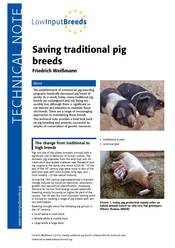
The establishment of commercial pig breeding programs drastically decreased pig breed diversity. As a result, today, many traditional pig breeds are endangered and risk being irreversibly lost, although there is significant social interest and intention to maintain these old breeds. There are a range of encouraging approaches to maintaining these breeds.
This technical note provides a brief look back on pig breeding and presents successful examples of conservation of genetic resources.
Citation and Download
Friedrich Weißmann (2014): ![]() Saving traditional pig breeds. (598 KB) LowInputBreeds technical note 3.3. Consortium of the LowInputBreeds project. Newcastle and Frick.
Saving traditional pig breeds. (598 KB) LowInputBreeds technical note 3.3. Consortium of the LowInputBreeds project. Newcastle and Frick.
3.4 Adaptation of sows to rising temperatures
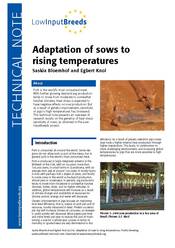
Pork is the world’s most consumed meat. With further growing demand pig production tends to move from moderate to somewhat harsher climates. Heat stress is expected to have negative effects on sow production. But as a result of genetic improvement, sensitivity of pigs to high temperatures has increased.
This technical note presents an overview of research results on the genetics of heat stress sensitivity of sows, as obtained in the LowInputBreeds project.
Citation and download
Bloemhof, S. and Knol, E. (2014): ![]() Adaptation of sows to rising temperatures. (203 KB) LowInputBreeds technical note 3.4. Consortium of the LowInputBreeds project. Newcastle and Frick.
Adaptation of sows to rising temperatures. (203 KB) LowInputBreeds technical note 3.4. Consortium of the LowInputBreeds project. Newcastle and Frick.
3.5 Piglet management in organic and low-input systems
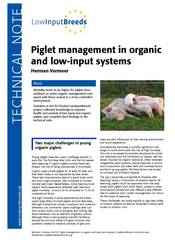
Mortality tends to be higher for piglets born outdoors or under organic management compared with those reared in a more controlled environment.
Scientists in the EU-funded LowInputBreeds project collected knowledge to improve health and survival of low-input and organic piglets, and compiled their findings in the technical note.
Citation and Download
Vermeer, Herman (2014): ![]() Piglet management in organic and low-input systems. (349 KB) LowInputBreeds technical note 3.5. Consortium of the LowInputBreeds project. Newcastle and Frick.
Piglet management in organic and low-input systems. (349 KB) LowInputBreeds technical note 3.5. Consortium of the LowInputBreeds project. Newcastle and Frick.
4.1 Breeding of laying hens
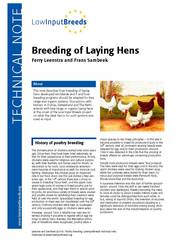
Worldwide most commercial hens are kept in small groups in cages. In some parts of the world there is the trend that laying hens are being housed in large groups and some of them with outdoor access.
This note describes how breeding of laying hens developed worldwide and if and how breeding programs should be adapted for free range and organic systems. Discussions with farmers in France, Switzerland and The Netherlands with free range or organic laying hens at the onset of the Low Input Breeds project on what the ideal hen is for such systems was used as input.
Citation and Download
Leenstra, F. and Sambeek, F. (2014): ![]() Breeding of Laying Hens (326 KB). LowInputBreeds technical note. 4.1. Consortium of the LowInputBreeds project. Newcastle and Frick.
Breeding of Laying Hens (326 KB). LowInputBreeds technical note. 4.1. Consortium of the LowInputBreeds project. Newcastle and Frick.
4.2 Regional high protein feeds for poultry diets
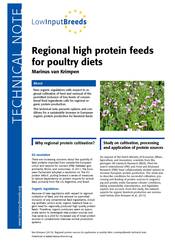
New organic regulations with respect to regional cultivation of feed and removal of the permitted inclusion of low levels of conventional feed ingredients calls for regional organic protein production.
This technical note presents options and conditions for a sustainable increase in European organic protein production for livestock feeds.
Citation and Download
Van Krimpen (2014): ![]() Regional high protein feeds for poultry diets. (388 KB) LowInputBreeds technical note 4.2. Consortium of the LowInputBreeds project. Newcastle and Frick.
Regional high protein feeds for poultry diets. (388 KB) LowInputBreeds technical note 4.2. Consortium of the LowInputBreeds project. Newcastle and Frick.
4.3 Egg quality
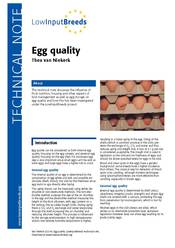
Egg quality can be considered as both internal egg quality, focusing on the egg content, and external egg quality, focusing on the egg shell. For producers egg size is also important since small eggs can't be sold as table eggs and large eggs have a higher risk to crack.
This technical note discusses the influence of flock nutrition, housing and other aspects of bird management as well as egg storage on egg quality and how this has been investigated under the LowInputBreeds project.
Citation and Download
Van Niekerk, T. (2014): ![]() Egg quality (618 KB). LowInputBreeds technical note 4.3. Consortium of the LowInputBreeds project. Newcastle and Frick.
Egg quality (618 KB). LowInputBreeds technical note 4.3. Consortium of the LowInputBreeds project. Newcastle and Frick.
4.4 Managing free range laying hens
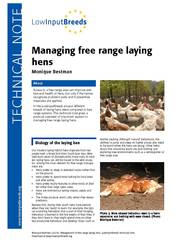
Access to a free range area can improve wel-fare and health of hens, but only if the farmer recognises problems early and if preventive measures are applied.
In the LowInputBreeds project different breeds of laying hens were compared in free range systems. This technical note gives a practical overview of important aspects to managing free range laying hens.
Citation and Download
Monique Bestman (2014): ![]() Management of free range laying hens (1.0 MB). LowInputBreeds technical note 4.4. Consortium of the LowInputBreeds project. Newcastle and Frick.
Management of free range laying hens (1.0 MB). LowInputBreeds technical note 4.4. Consortium of the LowInputBreeds project. Newcastle and Frick.
4.5 Raising cockerels from free range egg production
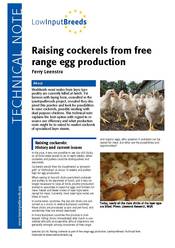
Worldwide most males from layer type poultry are currently killed at hatch. Yet farmers with laying hens, consulted in the LowInputBreeds project, revealed they despised this practice and look for possibilities to raise cockerels possibly working with dual purpose chickens.
This technical note explains the best option with regard to resource use efficiency and what production costs might be to raise and market cockerels of specialized layer strains.
Citation and download
Leenstra, Ferry (2014): ![]() Raising cockerels from free range egg production (182 KB). LowInputBreeds Technical Note 4.5. Consortium of the LowInputBreeds project. Newcastle and Frick.
Raising cockerels from free range egg production (182 KB). LowInputBreeds Technical Note 4.5. Consortium of the LowInputBreeds project. Newcastle and Frick.
 This website was archived on December 19, 2017 and is no longer updated.
This website was archived on December 19, 2017 and is no longer updated.

